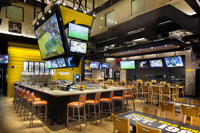Buffalo Wild Wings unveiled a new look Monday at a new restaurant in Cincinnati that aims to bring the feel of the sports stadium to its casual-dining locations.
Recreating the stadium experience is not about replicating the stadium seating and scoreboards, but capturing the same energy and social interaction of the ballpark, officials for Minneapolis-based casual-dining chain told Nation’s Restaurant News Monday from the grand opening of the new prototype.
SLIDE SHOW

A look at Buffalo Wild Wings' Cincinnati prototype
RELATED
• Commodity inflation curbs 3Q income for Buffalo Wild Wings
• Buffalo Wild Wings kicks off NFL season with new ad campaign, sweepstakes
• More casual-dining restaurant news
“If you’re not in the stadium to watch the game, then we want you to be here,” said Bob Ruhland, vice president of marketing. “Getting the restaurant as close to the environment and feel of that stadium is what we’re striving for.”
The brand of nearly 900 units is scheduled to open another new prototype in San Diego. Most of its new openings and all remodels in 2013 will adopt the design of this prototype.
Buffalo Wild Wings is targeting incremental traffic from its core demographic groups rather than trial from new guests with the new design, Ruhland said. Based on consumer research from Simmons, Buffalo Wild Wings has identified a market of about 26 million core guests, or “MVPs,” he added.
“We’re currently getting about 6 million of those MVPs [in the restaurants] regularly,” he said. “Proximity is a big deal in that, but we feel there’s a huge opportunity to find that other 12 million to 20 million people who are light guests. We look at Buffalo Wild Wings as being the sports fan’s biggest fan [with these changes].”
Subbing in new styles
Bill Ferris, the brand’s director of store design, said the new prototype was developed to gain efficiencies in both the front and back of the house.
Dining spaces are more clearly divided into zones, allowing some guests to choose a quieter, more intimate place to eat near the front of the restaurant, while others opt to be closer to the action, which Buffalo Wild Wings is attempting to corral around the bar in the center of the dining room.
The Cincinnati prototype has 80 TV screens in the dining room to give guests more opportunities to watch different games, and the acoustics were re-engineered to optimize the sound of the main game being played. Ferris estimated that the prototype’s total audiovisual components would increase approximately 20 percent to 25 percent.
Creating a community
The chain designed the central bar in the shape of a horseshoe to get people talking to each other when they are not watching games on the giant TVs above.
“The bar has been redesigned to encourage a lot more social interaction,” Ferris said. “Instead of looking at a wall, [customers] are looking around the bar at other guests.”
Beer selections will be called out more with a large keg display on the wall near the bar and with beer taps directly in front of guests’ seats, Ferris added.
The front entrance and host stand will be more focal parts of the front of the house with more branded graphics, memorabilia from local sports teams, and some retail elements of sauces and rubs to tell more of the brand’s story, Ruhland and Davis said.
“In terms of the design, we’ve introduced more daylight into the restaurant,” Ferris added. “That should have a good effect on earlier dayparts like lunch.”
The back of the house was redesigned as well, and accounts for much of the increase in square footage to 6,700 square feet in Cincinnati, compared with about 6,100 square feet in a typical location’s footprint. Cooking lanes were laid out differently and more space was added to the restaurant’s walk-in cooler.
Buffalo Wild Wings worked with Columbus, Ohio-based design consultancy Fitch on the prototype.
Teams get new captains
The Cincinnati prototype is among Buffalo Wild Wings locations to test the use of guest experience captains, who are front-of-the-house staff members who assist managers and servers by getting groups of diners set up with the sports events they want to watch and addressing questions and concerns.
The guest experience captains ensure that guests’ needs beyond food and beverage are covered, Ruhland said.
“Everybody’s relationship with Buffalo Wild Wings is different,” he said. “Some people come in to watch a game they can’t get at home, so who is going to understand that need and cater to that? We feel guest experience captains can.”
In addition to setting the diners up with their preferred game on the nearest TV, the guest experience captains also would bring samples of new menu items or the seasonal and craft beers on special during a particular marketing window, Ruhland added. They also will be the staff members in charge of promoting the chain’s loyalty club.
Buffalo Wild Wings operates or franchises restaurants in 49 states and Canada.
This article has been revised to reflect the following corrections
Correction: December 19, 2012 An earlier version of this article inaccurately stated that the new prototype opened in Cincinnati by Buffalo Wild Wings was a remodeled store, when it in fact was a new building. An earlier version of this article also mischaracterized Bill Ferris’ estimation about the location’s audiovisual upgrades. The total number of audiovisual components in the prototype, not the location’s costs for operating the equipment, would increase by 20 percent to 25 percent.
Contact Mark Brandau at [email protected].
Follow him on Twitter: @Mark_from_NRN

